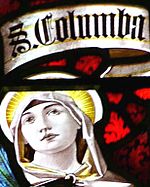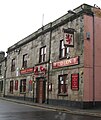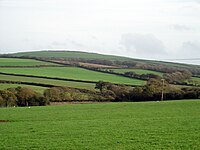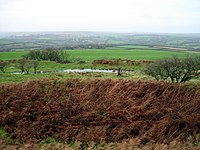St Columb Major
| St Columb Major | |
| Cornwall | |
|---|---|
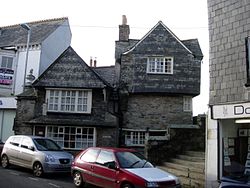 Glebe House, St Columb Major | |
| Location | |
| Grid reference: | SW912633 |
| Location: | 50°25’55"N, 4°56’24"W |
| Data | |
| Population: | 3,984 (2001) |
| Post town: | St. Columb |
| Postcode: | TR9 |
| Dialling code: | 01637 |
| Local Government | |
| Council: | Cornwall |
| Parliamentary constituency: |
St Austell and Newquay |
St Columb Major is a village in Cornwall, often referred to locally as St Columb. It is approximately seven miles southwest of Wadebridge and six miles east of Newquay. The designation Major distinguishes it from the smaller village of St Columb Minor, further west by the edge of Newquay.
Twice a year the town plays host to hurling, a mediæval game once common throughout Cornwall but now only played in St Columb and St Ives.[1] Hurling is a Shrovetide game, played on Shrove Tuesday and then again on the Saturday eleven days later. The game involves two teams of several hundred people (the 'townsmen' and the 'countrymen') who endeavour to carry a silver ball made of apple wood to goals set two miles apart, making the parish, around 25 square miles in area, the de facto largest sports ground in the world.[2]
Contents
Church
The church is dedicated to St Columba a local saint: her well is at Ruthvoes. For most of the Middle Ages the church belonged to the Arundells of Lanherne and was lavishly endowed.
The tower is a fine example of a fifteenth-century building, consisting of four stages with battlements and pinnacles. It is 8 feet high and contains eight bells re-hung in 1950. In 1920 the chiming clock was added as a memorial to the men of St. Columb who died in the Great War. In 1860 plans were drawn up by William Butterfield, in hope of St. Columb church becoming the cathedral of the future diocese of Cornwall, but the cathedral was built at Truro.[3]
Some of the more interesting items are some fine brasses, including Sir John Arundell (died 1545, perhaps not buried here; Sir John Arundell, 1591, and his wife (died 1602, brass engraved 1635); John Arundell and his wife, 1633 (on the same stone).[4] There is also fine wooden screen by the architect George Fellowes Prynne.[5] and some exceptional oak benchends, dating as far back as 1510. The fine organ is by Bryceston Bros. & Ellis of London and a "Letter of Thanks" to the Cornishmen sent by Charles I in 1643 is found in many Cornish churches. There are also two sculptures by the artist Allan G Wyon and a stained glass window portraying St Columba. In the churchyard is St Columba's Cross.
Architecture
The older part of the town follows a linear layout along Fair Street and Fore Street. Many houses on the narrow main street are slate hung. The Cornish architect Silvanus Trevail designed Lloyds Bank, The school. Private houses by Trevail include Ashleigh house (1896) and Treventon house (1897). There are some good examples of work by the architect William White, including Bank House (circa 1857),[6] Rosemellyn House (1871)[7] Penmellyn House[8] and the Old Rectory.[9]
The Retreat[10] was formerly St Columb Workhouse and was designed by George Gilbert Scott.
The oldest house in St Columb is the Glebe house,[11] near the church, which is now a tea room.
History and antiquities
Bronze and Iron Ages
Monuments that date from this period include: Castle an Dinas, an Iron Age hillfort.;[12] the Nine Maidens stone row, the largest row of standing stones in Cornwall;[13] the Devil's Quoit (sometimes recorded as King Arthur's Quoit);[14] and King Arthur's Stone (this long lost stone is said to be not far from the Devil's Quoit near St. Columb, on the edge of the Goss moor). It was a large stone with four deeply-impressed horseshoe marks. Legend has it that the marks were made by the horse upon which Arthur rode when he resided at Castle An Dinas and hunted on the moors.
Middle Ages and early modern period
In 1333 Edward III granted a market in St Columb Major to Sir John Arundell. This was as a reward for supplying troops to fight the Scottish at the Battle of Halidon Hill near Berwick-upon-Tweed.
Following the Prayer Book Rebellion of 1549, William Mayow the Mayor of St. Columb was hanged by Provost Marshal, Anthony Kingston outside a tavern in St Columb as a punishment leading an uprising in Cornwall.[15][16]
In 1645 during the English Civil War, Sir Thomas Fairfax's troops were advancing from Bodmin towards Truro; on 7 March the army held a rendezvous, and halted one night, four miles beyond Bodmin. The King's forces were quartered at this time near St. Columb, where a smart skirmish took place between the Prince's regiment and a detachment of the Parliamentary army under Colonel Rich, in which the latter was victorious.[17]
In the year 1676, the greatest part of the church of St Columb was blown up with gunpowder by three youths of the town.[18]
Twentieth century
Royal visits were made to St Columb in 1909, 1977 and 1983. On 9 June 1909 the town was visited by the Prince of Wales (George V) and his wife, the Princess of Wales (Mary of Teck). The visit was to open the Royal Cornwall Agricultural Show. The Prince gave 2 silver cups: one for the best bull and another for the best horse.[19] In August 1977 The Queen and Prince Philip visited the town during their Silver Jubilee tour of Cornwall. On 27 May 1983: The town was visited by the Prince and Princess of Wales (Prince Charles and Princess Diana). The visit was to commemorate the 650th anniversary of the signing of the town charter by Edward III.[20] A plaque commemorates this visit outside the Conservative club in Union Square.
In 1992 Australian stuntman Matt Coulter alias "The Kangaroo Kid" set the record for the longest jump with a crash on a quad bike at Retallack Adventure Park, St Columb Major.[21]
Geography
St Columb is situated in mid-Cornwall, about 5 miles inland from the north coast. The parish of St Columb Major covers 12,884 acres rising to a highest point of 709 feet at Castle an Dinas, the site of an iron-age hill fort about 2 miles east of the village.
Much of the land in the parish is used for farming (both arable and pastoral), with small areas of woodland. There is also some moorland in the generally slightly higher northern and eastern parts of the parish, notably part of the Goss Moor in the southeast, Castle Downs below Castle an Dinas (east) and an area of moorland adjoining Rosenannon Downs (northeast). The Vale of Lanherne, the valley of the River Menalhyl (see below) is famed for its beauty and occupies the area to the west of the town, connecting St Columb and St Mawgan churchtown.
The north part of the village (known as 'Bridge') descends into the Vale of Lanherne. It was originally a linear settlement built on the main road running north-east to south-west, but modern estates have since been built, extending the town to the south and east. In the older part of the settlement there is much high-density housing with relatively narrow streets, and the shops and pubs of the village. To the south there is an industrial estate.
Hamlets around the parish, including Talskiddy and Gluvian in the north, Ruthvoes (southeast), Trebudannon (south), Tregaswith (southwest), Tregatillian (east) and a large number of smaller farming settlements and isolated dwellings. There are also Halloon, Lanhizey, Rosedinnick, Tregamere, Trekenning, Trevarron, Trevolgas and Trugo.[22]
In literature
- Castle Dor by Daphne du Maurier features St Columb several times. In particular it mentions the parish church, Castle An Dinas, The Red Lion Inn and Tresaddern Farm.[23]
- Kangaroo, a novel by D H Lawrence first published in 1923, has a fictional character named Alfred John Trewhella from St Columb. The novel though is set in Australia.
See also
Outside links
References
- ↑ It is also played irregularly and less frequently at Bodmin, but nowhere else.
- ↑ Hornby, Hugh (2008). Uppies and Downies: The extraordinary football games of Britain. English Heritage. p. 142. ISBN 978-1-9056246-4-5.
- ↑ "''The Gentleman's Magazine'', 1860, p. 147". Google.co.uk. http://www.google.co.uk/books?id=oAn5xswcKFEC&pg=PA147&dq=butterfield+st+columb&as_brr=1. Retrieved 2013-01-31.
- ↑ Dunkin, E. (1882) Monumental Brasses. London, Spottiswoode; pp. 27–31, 75–82, pl. XXVII, LVI, LVII
- ↑ George Fellowes Prynne - St Columb screen
- ↑ National Heritage List 1144073: Bank House
- ↑ National Heritage List 1144095: Rosemellyn House
- ↑ National Heritage List 1327399: Penmellyn House
- ↑ National Heritage List 1144096: The Old Rectory
- ↑ National Heritage List 1144064: The Retreat
- ↑ National Heritage List 1144067: The Glebe House
- ↑ "A Gazetteer of Arthurian Topographic Folklore". http://www.arthuriana.co.uk/concepts/folkgazt.htm. Retrieved 7 March 2006.
- ↑ "The Modern Antiquarian site#627". http://www.themodernantiquarian.com/site/627. Retrieved 24 September 2006.
- ↑ "The Modern Antiquarian site#644". http://www.themodernantiquarian.com/site/644. Retrieved 24 September 2006.
- ↑ Redding, Cyrus (1842). An illustrated itinerary of the county of Cornwall. How & Parsons. p. 47. http://www.google.co.uk/books?id=gs8HAAAAQAAJ&pg=PA7&dq=pendarves+st+columb#PPA47,M1. Retrieved 4 september 2007.
- ↑ Payton, Philip (1996) Cornwall. Fowey: Alexander Associates
- ↑ From: 'General history: Historical events' - Magna Britannia: volume 3: Cornwall (1814), pp. X-XXIV
- ↑ Gilbert, Davies The Parochial History of Cornwall
- ↑ . The Times, Thursday, 10 June 1909; pg. 9; Issue 38982
- ↑ . The Times, Saturday, 28 May 1983; pg. 10; Issue 61544
- ↑ Crashing Records - Johnnyairtime.com
- ↑ "St Columb Major". GENUKI. http://www.genuki.org.uk/big/eng/Cornwall/StColumbMajor/. Retrieved 7 September 2010.
- ↑ "''Castle Dor''". Dumaurier.org. http://www.dumaurier.org/dor.html. Retrieved 2013-01-31.
